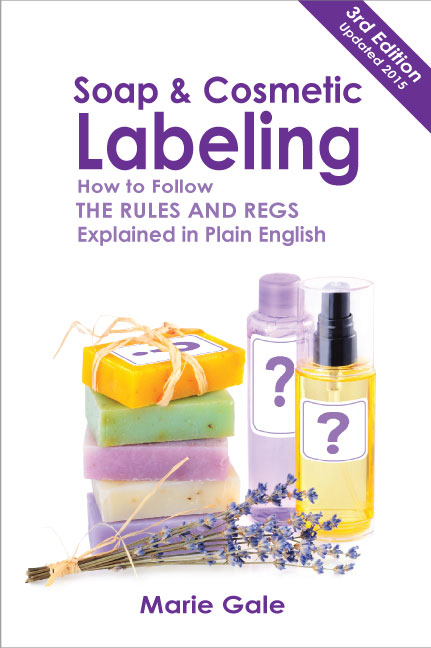Important Note: The information on this page applies only to soap and cosmetic regulations in the United States. Most other countries require that the Latin name for botanicals is used in the ingredient declaration.
There has been considerable discussion over the years on how botanicals should be listed in the ingredient declaration for cosmetics. Based on some recently posted information on the FDA website, it is now clear that common names are required, and when used as a secondary listing, Latin names are accepted.
Although the “INCI name” (which usually means the Latin name) is commonly thought to be required, it isn’t—it’s optional.
Actual Law and Regulation
The actual law and regulation governing the way ingredients should be identified in cosmetic ingredient declarations comes from several sources.
Fair Packaging and Labeling Act
The Fair Packaging and Labeling Act (FPLA) was enacted in 1967. It sets specific requirements for the labeling of consumer commodities (that is, products that are used by consumers and generally used up over time). The FPLA directs the Federal Trade Commission and the Food and Drug Administration to issue regulations to implement the requirements outlined in the FPLA. The FDA is responsible for the regulations applying to foods, drugs, and cosmetics.
The FPLA specifies that when the ingredients must be listed, the common or usual name is used.
Directly from the regulations:
“The label on each package of a cosmetic shall bear a declaration of the name of each ingredient…”
21 CFR 701.3
Later on in the regulations, the acceptable source of ingredient names is listed.
For botanicals, the name should be either as identified in the CTFA Cosmetic Ingredient Dictionary, Second Ed (1977)—which listed botanicals by their common English name—or if not listed there, the name generally recognized by consumers. Either way, the correct wording is the common name, which complies with the FPLA requirements.
How Did the Latin Name Get Included?
In 1995, the CTFA (now called the Personal Care Products Council [“PCPC”]) published their 6th edition of the Cosmetic Ingredient Dictionary, which used the Latin genus and species names of botanicals in parenthesis along with the common name [e.g., Peppermint (Mentha peperita) Oil].
Then, in the 8th edition, published several years later, PCPC again changed the way botanicals were identified. In that edition, botanicals were named first by the Latin genus and species and then with the common name in parenthesis [e.g., Mentha peperita (Peppermint) Oil].
The goal, I think, was to standardize and harmonize the ingredient naming standards between the US and other countries, which were moving toward requiring the Latin names for ingredients.
Most people, including myself, figured that the PCPC and the FDA were on the same page and that, so long as the common name was included, any of the different versions were okay to use.
Are the Regulations Changed?
It appears that when it comes to using the Latin name for botanicals in ingredient listings, the FDA and PCPC aren’t on the same page after all. In the last several months, the FDA has posted several documents on their website that give some insight into their position.
In March 1995, the CTFA wrote the FDA in preparation of their upcoming 6th edition of the Cosmetic Ingredient Dictionary, requesting that the FDA agree not to take action against labelers using the Latin genus and species to identify botanicals. They sent a follow-up letter changing the original request, asking that dual names be allowed as part of a “transition period.”
In June, 1995, the FDA responded. The section concerning the Latin names for botanicals is quoted here [emphasis added]:
The use of Latin names as the primary identifying term for plant extract ingredients, with the current common name appearing imbedded in parenthesis, would not be consistent with the FPLA. The statute requires the use of the common or usual name, and there is no way that such a requirement can be considered to be met by the placement of the recognized common or usual name in parentheses after the Latin name. Nor is the agency willing to accept the Latin name as the common or usual name of such ingredients.
Later in the document, the FDA went on to say:
If the CTFA petitions the agency to amend the cosmetic ingredient labeling regulations to specifically provide for the declaration of plant extracts by their common or usual name followed in parenthesis by their Linne INCI name in the ingredient statement, we would be unlikely to object during consideration of the petition to products intended for sale and distribution in the United States that bear such a dual declaration in the ingredient statement.
Following that exchange, in 1996, the CTFA filed an official Citizen Petition to the FDA to have the regulations changed to have the 6th edition recognized as the official source of ingredient names, including that the Latin genus and species be required in parenthesis when identifying botanical ingredients.
The FDA’s response, in July, 1997, said:
The purpose of this letter is to advise you, in accordance with 21 CFR 10.30 (e), that we have not been able to reach a decision on your petition within the first 180 days of the filing of the petition, because of the limited availability of resources and other agency priorities.
Please be assured that your Petition is under active review at the present time, and a more substantial response reflecting the agency’s determination of the merits of the several elements of the Petition will be forthcoming as soon as possible.
No further documents seem to be available on the FDA website concerning the status of the matter.
Note that PCPC continued to issue new editions of the Cosmetic Ingredient Dictionary, and as of the 8th edition, changed the nomenclature for botanicals to the Latin name with the common name in parenthesis—although that is clearly contrary to the FPLA.
What Does the FDA Want and Expect?
It’s very clear that the FDA, in accordance with the Fair Packaging and Labeling Act, wants the common name as the primary name used for botanical ingredients in the ingredient declaration.
That they “wouldn’t object” to having the Latin name as a secondary name (in parenthesis) is confirmed in a 2011 video on cosmetic labeling in which it is stated that the Latin name may be used that way, but the common name should be used first. (The quote is at about 12:16 into the video.)
So, bottom line, the FDA wants and expects the common name for any botanical ingredients. If you want to include the Latin genus and species, you can do so—but only if it is in parenthesis embedded inside the common name.
Doesn’t that make labeling a little easier?



Leave a Reply